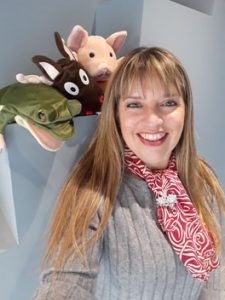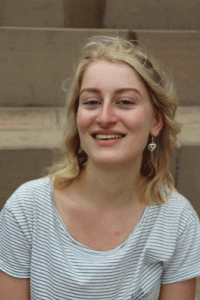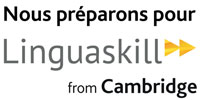Good practice in the CapEnglish Network
Good Practice Contest winners
Our panel of judges, which included members of the Cap English team, chose the winning entry based on how well it exemplified the entry requirements.
1. Tracy Burton, Avignon

PUPPET PLAY!
Age/level: 6+
Number of children: 2+
Duration: 1 hour including performance
Targeted competences: Critical thinking, collaboration, communication, creativity, language learning, self-confidence & FUN!
Materials:
Teacher: 2+ puppets
Students: 1 sheet of paper & 2 coloured pens
Detailed procedure:
• Introduce the Puppets to the children whilst doing a little performance using unique voices for each puppet! Ask them what type of animal they are and ask them to repeat the name together and then give the puppet names!
(You could make a competition and the winner choses the names)!
• Explain that today’s session is an English theatre performance/role play that they do in front of their classmates.
• Explain that they write their own performance using the puppets of their choice working in pairs.
• Each child chooses a different colour pen and they write their performance together, sharing ideas and making the performance as long as possible asking lots of questions.
• For example; one child chooses the pig puppet and uses a pink pen for his chosen words and the other child chooses the frog puppet and chooses the green pen.
Pig « Hello!»
Frog « Hello!»
Pig « What’s your name? »
Frog « My name is Kermit the Frog»
Pig « It’s nice to meet you »
Frog « What’s your name?»
Pig « My name is Pepper Pig»
Frog « It’s nice to meet you too»
Pig « Where do you live? »
Frog « I live in Marseille»
Pig « What’s your favourite sport? »
Frog « My favourite sport is swimming» etc. etc.
• Write some examples on the board to help them.
• Monitor their progress and offer help and support where needed, inspire them to use their imaginations!
• After 15/20 ask if anyone’s finished and check their work before they perform.
• Remind them its a performance and everyone must watch, listen and clap afterwards.
• Introduce the students as they take their puppets and count down 5, 4, 3, 2 , 1 or ‘ready, steady, GO’!
all together for the start!
• The children should be reminded to speak in their best English loudly and clearly.
• Correct their pronounciations if necessary during the play.
• Children love this! They are very excited and this can be practised more often when introduced to new vocabularly.
ENJOY!
2. Hayley Valentine, Toulouse
 Lesson Plan
Lesson Plan
Level = CM1
Number of Children = 25
Duration = 1 hour
Lesson Objectives:
1. To revise previous topics: weather, weekdays, months, seasons, feelings (“how are you?”), animals, adjectives, “to be” verb table (affirmative/negative), “to have” verb table (affirmative/negative).
2. To review all classroom objects with the question “what do you have in your school bag?”
3. To revise clothing items from last week’s class.
4. To introduce the family members (if there is time).
Targeted Competences =
A. SPOKEN – to express oneself through engaging in basic conversation about the possession of objects, one’s outfit and their family.
B. LISTENING – to understand simple questions about the possession of objects, one’s outfit and their family.
C. WRITTEN – to understand the grammatical rules for verbs and to employ them in a real-life setting.
D. READING – to be able to read and understand simple sentences about one’s current environment, e.g. the date and the weather.
Materials required = Flashcards – stationary (Rubber, pencil case, ruler, tissues, sharpener, bag, colour pencil, glue, board, pencil, bin, scissors, pen, book), clothing items (dress, shirt, t-shirt, shoes, bag, cap, trainers, shorts, jumper, hat, scarf, socks, trousers), family (mother, father, brother, sister, cousin, grandmother, grandfather, uncle, aunt).
Extra = printed copies of verb table (negative form of ‘to have’).
Detailed Procedure
Brief Introduction (5 mins)
• Hello everyone! (wave).
• How are you? Are you good? (actions – hands out, thumbs up).
• Write down the homework: apprendre la forme négative du verbe AVOIR (‘to have’).
Ritual/Revision (50 mins)
• Quick review of last year’s ritual:
– What day is it?
– What month is it?
– What is the season?
– How is the weather today?
• Write answers on the board (Today is Thursday the ….) then repeat.
• New ritual (translate sentences to practise the verbs, adjectives, animals):
– Affirmative form of “to be” (table) with feelings flashcards, e.g. how do you say “elle est malade” en anglais?
– Negative form of “to be” (add to table) with adjectives as examples, e.g. how do you say “je ne suis pas rapide”?
– Affirmative form of “to have” (table) with animal flashcards for examples, e.g. how do you say “j’ai un panda”?
– Introduce the negative form of “to have”:
1. Hand out homework sheet.
2. Read together.
3. Fill in the table (page 30).
• Stationary:
– Flashcards/repeat.
– Show me your… +object.
– Introduce the question “what do you have in your pencil case?” for each pupil to say:
A. “I have a…” and present the object.
B. “I don’t have a…”
– “Pencil case cowboy” – two pupils come to the front of the class with their pencil cases and they must find an object quicker than the other.
– What is your favourite object? Show us and explain why.
– Use colours to illustrate, e.g. dark blue bin.
• Clothing items:
– Flashcards/repeat.
– Flashcard games: Kim’s game.
– Review the question “what are you wearing?”
– Ask every pupil in turn, each pupil must tell us one item of clothing.
– Ask me (the teacher) the question and tell me what I am wearing.
– Play “Guess Who” by describing someone’s clothes.
– Work on pages 26-27.
New work (10 mins)
• Family:
– What do we know already?
– Flashcards/repeat.
– Practise “I have” (affirmative/negative) to discuss family members.
– Do page 29.
Conclusion
Did you enjoy learning English today? What would you like from the lessons?
Thank you so much! I shall see you next week on Monday. Have a good day!
3. Martyna Sochacka, Paris
 LESSON PLAN: “The Grinch”
LESSON PLAN: “The Grinch”
1. Age/level: CM1 or CM2
2. Number of children: 28-30
3. Duration: 45 min
4. Period: Christmas Time (for example the week just before the Christmas break)
5. Targeted “competence(s)”:
Savoir décrire un personage (l’apparence physique + character), savoir conjuguer le verbe être et avoir
6. Material:
Flashcards: revision of Christmas vocabulary
Video: The Grinch Movie Trailer 2018 (available on YouTube)
7. Detailed procedure:
Starter 5-10 min : question – Do you know The Grinch character? (teacher can write his name on the board)
Can you describe The Grinch? [probably single words will appear, such as: green, big, monster etc. – teacher can write them on the board]
Presentation 5 min: new adjectives – for example grumpy, mean, hairy,belly (flashards)
Activity 1-5 min: watch the video: students note down key-words
Activity 2-5 min: Oral expression – students describe The Grinch, full sentences only!
He is green etc.
Teacher’s help: verb – have He has a small nose. He has a big belly.
Activity 3-10 min: Written description in the student’s book
If there’s some time left – Teacher asks the question: What’s the opposite of “Like”? Some of the students can say – ‘hate’/’not like’
They can add one sentence to their description: The Grinch hates Christmas.
Activity 4 5-10 min: Students draw The Grinch
Homework: none (Christmas holidays) or they can finish their drawing at home


